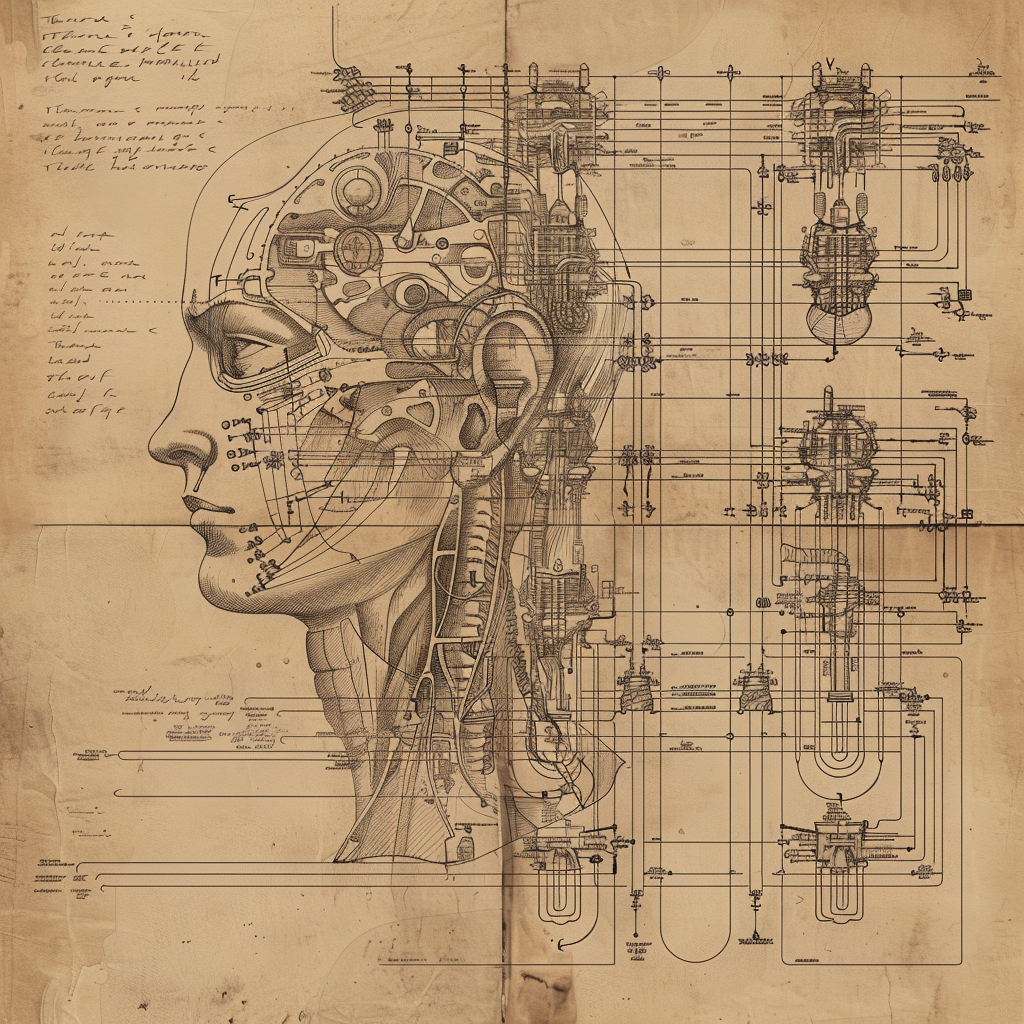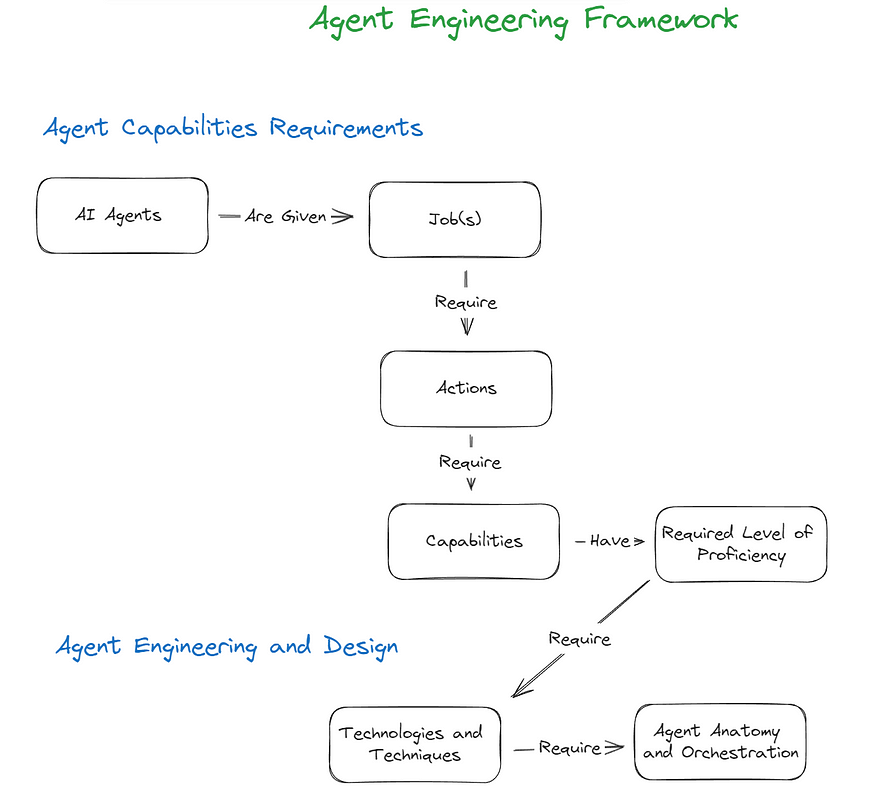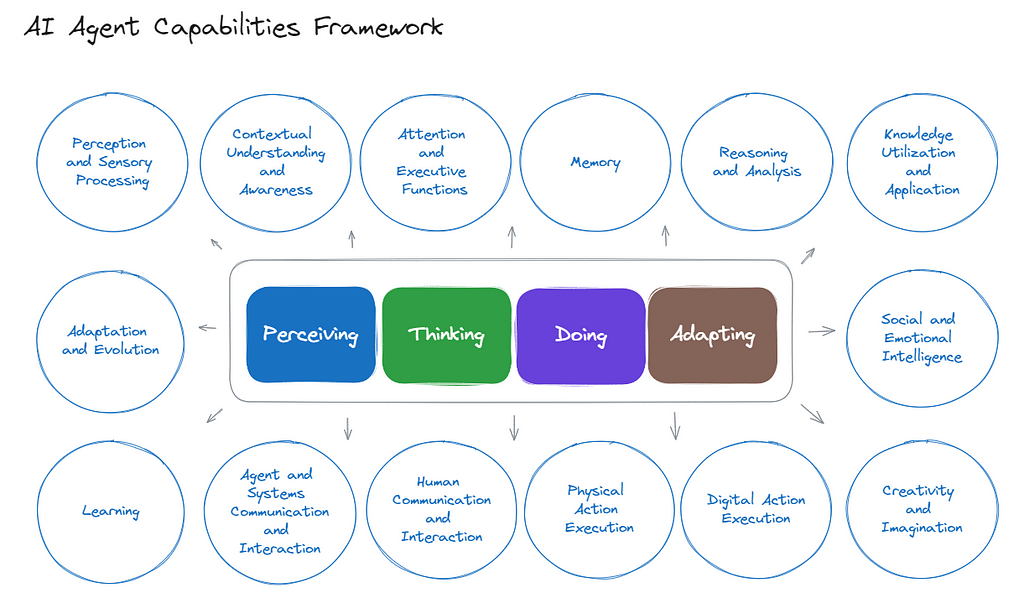
Introducing a high-level capabilities engineering framework for AI Agents

Introduction
In my recent article ‘From Prompt Engineering to Agent Engineering’ I proposed a framework for AI Agent Engineering that introduces a mental model for approaching the design and creation of AI agents. To recap the framework proposes the following structure:

- AI agents are given Job(s)
- Job(s) require Action(s) to complete
- Performing Action(s) requires Capabilities
- Capabilities have a Required Level of Proficiency
- The Required Level of Proficiency requires Technologies and & Techniques
- Technologies and Techniques require Orchestration
If you missed that article or need to refer back to it, you can find it here.
Although straightforward, on a deeper level, the framework tackles expansive topics and ideas. Drilling into the concepts surfaced by the broader framework is a substantial endeavor, and in this article, we continue our work by focusing on an AI Agent Capabilities Engineering Framework. The approach to this framework relies on a taxonomically oriented mindset, that extends concepts primarily rooted in cognitive and behavioral sciences.
Cognitive and Behavioral Science Foundations
As I have mentioned in other writings, throughout the history of human tool & technology development we have often used ourselves as the inspiration or model for what we are trying to build. A topical example of this in AI itself is the neural network which was inspired by the human brain. In an effort to build a framework for AI Agent Capabilities it seems natural then to turn to cognitive and behavioral sciences for inspiration, guidance and extension of useful concepts. Let’s first get a high-level grasp on what these sciences entail.
Cognitive Science
Cognitive science is the interdisciplinary study of the mind and its processes, encompassing areas such as psychology, neuroscience, linguistics, and artificial intelligence. It provides critical insights into how humans perceive, think, learn, and remember.
Behavioral Science
Behavioral science is an interdisciplinary field that studies cognitive processes and actions, often considering the behavioral interaction between individuals and their environments. It includes disciplines such as psychology, sociology, anthropology, and economics.
As the expectations for what AI agents can accomplish continue to reach new heights, grounding our capabilities framework in cognitive and behavioral theories should give us a solid foundation to begin to meet those expectations and help us unlock a future where AI agents are equipped to perform complex jobs with human-like proficiency.
AI Agent Capabilities Framework
Before we dive into the minutiae let’s consider on a high-level how we might categorize the so-called ‘capabilities’ that power the ‘actions’ our agents need to take in an effort to perform their ‘jobs’. I propose that in general they fall into the categories of Perceiving, Thinking, Doing and Adapting. From there we can move on to identifying example capabilities in these categories on a more granular level. Although the resulting framework is categorically cohesive, bear in mind that the implied relationships between granular capabilities and categories are approximate. In reality the capabilities are heavily intertwined throughout the framework and trying to model this multi-dimensionality does not feel particularly useful at this stage. Below is a visual representation of the major categories and sub-categories that make up the framework without the categorical alignments that you will see shortly.

While our primary focus is driven by LLM-centered AI Agent Engineering, to future-proof and allow for the expansion of these frameworks into the realm of embodied AI and robots, we incorporate concepts that would be applicable in these settings as well.
Finally we do not deal with autonomy explicitly in the framework as it is more appropriately an overarching characteristic for a given agent or one of more of its capabilities. That said, autonomy is not necessarily a requirement that must be met for an agent to be effective in its given job(s).
With that foundation in place, let’s expand out the entire framework.
Perceiving
Encompasses the capabilities through which Agents acquire, interpret, and organize sensory information from the environment. It involves the detection, recognition and understanding of the appropriate stimuli, enabling Agents to perform as expected. Examples of granular capabilities include:
- Visual Processing: Image and object recognition and processing.
- Textual Data Processing: Text recognition and processing
- Auditory Processing: Speech and sound recognition and processing
- Haptic Processing: Touch recognition and processing.
- Olfactory and Gustatory Processing: Scent recognition and processing.
- Sensory Integration: Combining data from different sensory inputs for cohesive understanding
Thinking
Refers to the capabilities that enable Agents to process information, form concepts, solve problems, make decisions, and apply knowledge. Examples of granular capabilities include:
Contextual Understanding and Awareness
- Contextual Awareness and Understanding: Recognizing and comprehending situational, environmental, spatial and temporal context.
- Self-Awareness and Metacognition: Self-awareness, self-monitoring, self-evaluation, metacognitive knowledge
Attention and Executive Functions
- Selective Attention: Focusing on relevant data while filtering out irrelevant information
- Divided Attention: Managing and processing multiple tasks or sources of information simultaneously
- Sustained Attention: Maintaining focus and concentration over prolonged periods
- Planning: Formulating a sequence of actions or strategies to achieve a specific goal.
- Decision Making: Analyzing information, assessing options, and choosing the best course of action.
- Inhibitory Control: Suppression of inappropriate or unwanted behaviors or actions.
- Cognitive Flexibility: Switching between thinking about two different concepts or thinking about multiple concepts simultaneously
- Emotional Regulation: Managing and responding to emotional experiences with appropriate emotions
Memory
- Short-Term Memory: Holding and manipulating information temporarily
- Working Memory: Actively processing and manipulating information
- Long-Term Memory: Storing and retrieving information over extended periods
Reasoning and Analysis
- Logical Reasoning: Drawing conclusions based on formal logic and structured rules
- Probabilistic Reasoning: Making predictions and decisions based on probability and statistical models
- Heuristic Reasoning: Applying rules of thumb or shortcuts to find solutions
- Inductive Reasoning: Making generalizations from specific observations
- Deductive Reasoning: Drawing specific conclusions from general principles or premises
- Abductive Reasoning: Forming hypotheses to explain observations
- Analogical Reasoning: Solving problems by finding similarities to previously encountered situations
- Spatial Reasoning: Understanding and reasoning about spatial relationships
Knowledge Utilization and Application
- Semantic Knowledge: Acquiring and applying general world knowledge and features that make up concepts
- Episodic Knowledge: Acquiring and using knowledge of specific events and experiences
- Procedural Knowledge: Knowing how to perform tasks and actions efficiently
- Declarative Knowledge: Acquiring and using factual information
- Language Comprehension: Understanding and interpreting language
Social and Emotional Intelligence
- Emotion Recognition: Detecting and interpreting emotions
- Social Interaction: Engaging with humans or other agents in socially appropriate ways
- Empathy: Understanding and responding to the emotional states of others
- Theory of Mind: Inferring and understanding mental states, intentions, and beliefs
- Social Perception: Recognizing and understanding social cues and context
- Relationship Management: Managing and nurturing long-term relationships
Creativity and Imagination
- Idea Generation: Producing new and innovative ideas
- Artistic Creation: Creating original artistic works such as music, visual art, and literature
- Imaginative Thinking: Envisioning and articulating new possibilities and scenarios beyond current reality
Doing
Description: Involves the capabilities through which Agents interact with the environment and perform tasks. It includes both digital and physical actions. This category of capabilities also covers communication and interaction, enabling the Agent to engage meaningfully with users and other systems. Examples of granular capabilities include:
- Digital Action Execution: Performing specific digital actions, including output generation, automation, problem-solving actions, decision implementation, and response actions.
- Physical Action Execution: Planning, initiating, and adjusting movements, integrating sensory information with motor actions, grasping and handling objects, and learning and adapting new motor skills.
- Human Communication and Interaction: Engaging in meaningful dialogues with users, handling multiple languages, and maintaining the context of conversations.
- Agent and Systems Communication and Interaction: Effectively communicating and coordinating with other AI agents and systems, using protocols and interfaces to exchange information, synchronize actions, and maintain interaction context across platforms.
Adapting
Description: Refers to the capabilities that allow Agents to adjust and evolve their behaviors, processes, and emotional responses based on new information, experiences, and feedback. To be clear, we are focused here on adaptation and learning capabilities of the agent in its operative state and not learning that happens within the context of enabling its foundational capabilities. In our framework that will be the domain of Tools & Techniques. Examples of granular capabilities include:
Learning
- Cognitive Learning: Acquiring knowledge through cognitive processes
- Imitation Learning: Acquiring new skills and behaviors by observing and replicating actions
- Experiential Learning: Learning through experience and reflection
Adaptation and Evolution
- Behavioral Adaptation: Adjusting behaviors in response to feedback or environmental changes
- Cognitive Adaptation: Modifying cognitive processes based on new information
- Emotional Adaptation: Adjusting emotional responses based on experiences and context
- Motor Adaptation: Adapting motor skills through practice and feedback
- Social Adaptation: Modifying social behaviors based on social cues and interactions
- Evolution: Long-term changes and improvements in behaviors and cognitive processes over time
Since this is intended to be an article and not a book, we won’t go into a detailed discussion on each of these example granular level capabilities. As much as I would like to believe that this is exhaustive, it’s at best a good start. Through iteration and feedback we will surely revise it, improve it and move towards a stable framework that might then be suitable for broader adoption.
Let’s turn now to some examples that illustrate the practical application of the framework and how it can be valuable in an agent engineering setting.
The AI Agent Capabilities Framework in Practice
The practical application of the AI Agent Capabilities Framework involves leveraging its structured concepts, rooted in cognitive and behavioral science, to facilitate the design thinking process. Given the diversity in how we will envision and articulate desired capabilities for our agents, this framework helps establish a common ground, fostering consistency and comprehensiveness in capability design and engineering. This will be particularly valuable as the expectation for the sophistication level of our AI Agent’s capabilities continues to grow. Let’s explore an example:
AI Agent for Customer Support
Let’s consider an AI agent whose job is to provide customer support and personalized product recommendations. Armed with the framework, let’s aim for a higher fidelity job and scenario description that paints a more vivid picture.
Job: Deliver exceptional and empathetic customer support and product recommendations, while proactively predicting sales trends and incorporating granular contextual elements for highly personalized interactions.
Scenario: It is a bustling online customer service environment, and our AI agent is tasked with not only resolving customer queries and making product recommendations but also enhancing the overall customer experience by anticipating needs and personalizing interactions. It is a job that encompasses a broad spectrum of actions and capabilities. A few years back, building some of these capabilities would have been completely out of reach. Can the capabilities for this job be effectively articulated using our AI Agent Capabilities Framework in an effort to ascertain its feasibility? Let’s take a closer look while bearing in mind that the below outline is not intended to be comprehensive:
Actions Required:
- Understand and interpret customer queries.
- Provide accurate and helpful responses.
- Escalate issues when appropriate.
- Predict sales trends based on customer interactions.
- Make product recommendations.
Capabilities Required:
- Perception
- Textual Data Processing: Recognize and understand written customer queries, including complex sentences and slang.
- Auditory Processing: Transcribe and comprehend spoken queries, even in noisy environments.
- Visual Processing: Interpret visual cues and body language during video support sessions.
2. Cognition
Contextual Understanding and Awareness:
- Temporal Awareness: Recognize seasonal trends and peak periods.
- Location Awareness: Understand geolocation data.
- Personal Context Awareness: Understand individual customer, their history and preferences.
Memory:
- Short-Term Memory: Retain recent interactions to maintain context.
- Long-Term Memory: Utilize past interactions for context.
Reasoning and Analysis:
- Probabilistic Reasoning: Identify patterns in customer interactions to predict future behavior.
- Deductive Logic: Apply logical frameworks to troubleshoot issues.
- Behavioral Analysis: Understand and interpret patterns in customer behavior.
- Trend Analysis: Understand current market trends and seasonal data.
Knowledge Utilization and Application
- Semantic Knowledge: Apply general world knowledge to understand and respond to queries.
- Episodic Knowledge: Use specific events and past experiences for relevant support.
- Declarative Knowledge: Access factual information for accurate responses.
Social and Emotional Intelligence
- Emotion Recognition: Detect and interpret customer emotions.
- Social Interaction: Engage with customers in a socially appropriate manner.
- Theory of Mind: Infer customer needs and preemptively offer solutions.
- Relationship Management: Build rapport with customers to foster loyalty.
Creativity and Imagination
- Imaginative Thinking: Envision new possibilities beyond current issues.
Action
Digital Interactions:
- Output Generation: Produce quick, accurate, and contextually appropriate responses.
- Product Recommendation Generation: Suggest products based on customer preferences, and other relevant analyses.
Human Communication and Interaction:
- Conversation Continuity: Maintain context over multiple interactions.
Agent and Systems Communication:
- Inter-Agent Coordination: Communicate with other AI systems to synchronize actions and share insights.
Adaptation
Learning:
- Experiential Learning: Continuously improve understanding of customer behavior.
Adaptation:
- Behavioral Adaptation: Adjust interaction style based on feedback.
- Cognitive Adaptation: Update knowledge with new information.
- Emotional Adaptation: Modify emotional responses.
Some of these insights might be a bit surprising. For example, should AI Agents have relationship management as a capability? Or how about AI Agents that are pseudo-embodied on screen and are capable of observing and responding to a whole new array of data points they can “observe” via video? For certain, there are a plethora of privacy concerns and issues to contend with, but not a concept that we should rule out entirely.
Creating Capabilities Through Technologies and Techniques
Although this article will not focus on an evaluation of Technologies and Techniques to enable capabilities we should address the question that naturally emerges after going through the above exercise. Don’t LLMs give us the tools for most of these capabilities right out of the box?
Although LLMs have certainly advanced the state-of-the-art by leaps and bounds, the simple answer is, no. And in cases like the capabilities for reasoning and analysis, even though LLMs can simulate what looks like reasoning or analysis quite impressively, it falls far short of the human capabilities for such. In short, LLMs provide a not entirely reliable but powerful shortcut to enabling many of these capabilities. They represent a very consequential evolutionary step in intelligence and interaction technologies and their unprecedented adoption helps explain why there is so much excitement around the idea of Artificial General Intelligence (AGI). Although the definition of what it actually entails is the subject debate, if achieved, it could be the go to technology solution for enabling many of the cognitive/behavioral capabilities described above.
Conclusion
I hope you find the AI Agent Capabilities Engineering framework to be an insightful approach for defining your AI agents’ capabilities. By integrating concepts from cognitive and behavioral sciences, this framework aims to guide the development of the capabilities needed for AI agents to perform complex tasks. The framework is relatively dense and will surely evolve over time. The key takeaway at this stage is the mental model centered around Perceiving, Thinking, Doing, and Adapting. These four high-level concepts on their own provide a very robust foundation for organizing and developing Agent capabilities effectively.
Thanks for reading and stay tuned for future refinements of this framework and extension of other aspects of the AI Agenting Engineering framework. If you would like to discuss the framework or other topics I have written about further, do not hesitate to connect with me on LinkedIn.
Unless otherwise noted, all images in this article are by the author.
AI Agent Capabilities Engineering was originally published in Towards Data Science on Medium, where people are continuing the conversation by highlighting and responding to this story.
Originally appeared here:
AI Agent Capabilities Engineering
Go Here to Read this Fast! AI Agent Capabilities Engineering
